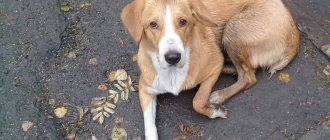What is chipping and why is it needed?
This procedure is one of the basic ones, therefore it is well worked out by veterinarians and does not cause any complications. Electronic identification of animals involves the introduction of a small capsule with a chip, which contains all the basic information about the animal.
A chip is a small microcircuit that stores all information about a dog and makes it easier to find it
For your information! Chipping is harmless to the dog, does not cause it discomfort, and does not limit its movement.
There are no laws in the Russian Federation that oblige owners to carry out this procedure; it is voluntary. However, the chip may be required to participate in exhibitions. It is also required to cross the borders of many European countries.
It is useful to microchip an animal just for safety reasons. After the procedure, the dog is entered into the database, indicating all the information about it and its owner. This helps you find your pet faster if it runs away.
Why are we No. 1 in Russia
The largest database of chipped animals in Russia with up-to-date data.
The only base combined with the two largest systems of microchipped animals.
Unique search by microchip number in more than 120 international databases.
The first database in Russia that contains information about animals using NFC tags.
Reliability and, in turn, confidentiality of personal data.
Maintaining information about animal vaccinations.
The animal card is fully translated into English.
The mobile version of the site is always at your fingertips.
Video instructions will help you quickly master working with the portal.
Prompt technical support.
Why enter animal data into the database?
Pedigree dogs with a pedigree and great value for breeding are primarily subject to microchipping. As a result of the procedure, the animal is assigned its personal ID, which contains all the information not only about itself, but also about its owner and ancestors. This helps prevent situations where a mongrel or a mixed breed is passed off as a purebred dog or sold with someone else’s documents.
A dog was bitten by a bee: what to do at home
In addition, the database helps in case of a missing animal. Thanks to the chip, you can determine its approximate location. Also, the information it contains, entered into the database, helps to identify the owner and confirm that this is really his pet.
Note! Animals without a chip are often not allowed to participate in exhibitions. If the owner’s plans include traveling with his pet to competitions, it is worth taking care of creating a questionnaire in the database in advance.
How does the procedure work?
Some owners refuse to have their pet microchipped for fear of hurting them. The procedure does not cause discomfort because it takes 1-2 minutes and does not require anesthesia:
- For long-haired breeds, the chip is inserted into the area of the withers or left shoulder blade. Before the procedure, the fur must be carefully pulled apart and the injection site disinfected.
- If the breed is short-haired or hairless, the chip is fixed on the inside of the thigh.
Before administration, the veterinarian must check the functionality of the transponder, remove it from the sterile bag and place it in the syringe. On the eve of the procedure, no additional preparation of the dog is provided, but the animal must be absolutely healthy. The transponder cannot be inserted until the pet is 1 month old; vaccinations are also required. It is better to have your dog microchipped at a veterinary clinic or dog training center to avoid becoming a victim of clever scammers. It is possible to carry out the procedure at home if the doctor works in the appropriate institution.
Databases of microchipped animals
How to stop a dog from barking at the dog and at everyone
After the procedure is completed, the owner receives a special code that allows him to identify the dog. All information about the animal captured in the chip is entered into the database. If your pet gets lost, you can simply enter the number to determine if someone has found it.
This small capsule stores all the information about the dog, which is also transferred to the database
ANIMAL-ID is one of the most common Internet portals among owners. The All-Russian unified database of microchipped dogs is a convenient platform that allows you to view information about your pet, its pedigree, vaccinations and diseases. If you lose an animal, you can place an ad indicating the breed, special features, and number.
AnimalFace is another platform that unites not only Russian, but also pets from the CIS countries. To check a dog's chip in the database, just enter its number, gender and breed of the animal. This is a convenient site to report a missing pet and inform other owners about your found pet.
Note! The advantage of the portal is that the data of the dog registered here is translated into English. This will help you travel easier.
What is pet microchipping?
Radio frequency identification is the latest method of identifying pets, with the help of which you can also find out and verify the accuracy of any information about the dog and its owner anywhere in the world.
Microchipping of dogs is most relevant for owners of purebred and breeding animals who often travel and participate in international exhibitions. However, even without a show career and trips abroad, microchipping of dogs is necessary for your pet to ensure its maximum safety, because with the help of an electronic identifier you can almost always identify the pet in the event of its theft or replacement, as well as if a particularly frisky pet runs away during daily walks and he will be taken to any veterinary clinic for identification.
Dog microchipping is a modern alternative to applying a breeding mark and is an electronic system consisting of a special microchip, a scanning device and a common database.
The microchip, inserted under the skin of the animal, is a transceiver module and a memory unit, made in integral form in a glass or ceramic case. The microchip's telecoil is activated by the scanner using an electromagnetic signal and transmits to the device a binary code that corresponds to a memory cell in a global database stored on multiple servers.
Microchipping dogs is similar to assigning them a uniform passport, which contains complete information about:
- Country and region of residence of the animal;
- His breed, status, health status and preventive vaccinations;
- Coordinates and contact details of its owner.
Currently, in Russia, microchipping of dogs is carried out in accordance with the ISO “Open Standard”, recognized by the majority of companies operating in the international market. In Russia, a unified database of chipped animals is located on the website, and also allows you to keep an electronic medical history of an animal from any clinic in the country and enter information about vaccination there.
Scanning device
When to feed your dog: before or after a walk
Scanners are actively used in veterinary clinics and some other places, for example, at the airport when registering a pet. The device allows you to easily read the information contained in the chip and display it on the screen. Thus, the data transfer process will take a matter of seconds.
The cost of such a scanner depends on its type. Prices in various stores start at 6,000 rubles* and can reach several times that amount.
What to do if the animal is not included in the database
Upon completion of microchipping, the dog must be entered into the database and its owner must be informed of its individual number. If for some reason this did not happen, and the staff of the veterinary clinic where the procedure was carried out did not register the dog, the owner must visit it again and clarify why information about his pet is still not available.
Important! In situations where the animal owner cannot contact the clinic and find out about entering data into the database, he can provide all the information about the pet himself. It is worth considering that you often have to pay for such a service.
“It’s very difficult to find a dog’s owner without a brand.”
Photo by Elena MIKHAILOVA
On the Internet we often come across such advertisements: “dog found”; “we are looking for good hands for the dog” or “the dog is lost.” But what is behind these messages, what do people do to help the dog get back to its owner, and what to do now so that in the future it will take less time to find the owner? The administrators of the cop dog assistance team, Elena Mikhailova and Nadezhda Sovenok, told us about this.
Please tell us briefly about your team.
— Our team has existed for two years. On the VKontakte network it is called “Team to Help Kurtshaars and Drathaars”, but is not registered anywhere. The first year we collected advertisements about lost cops and posted them on the Internet. Gradually, a team of administrators was formed. There are currently five active admins. And there are many volunteers; people from all over Russia and neighboring countries follow us on social networks.
— What search methods do you usually resort to?
— First of all, we monitor the Internet for advertisements about lost dogs in all cities of Russia and neighboring countries. Our main platform: hunting sites, Instagram, VKontakte, Odnoklassniki, Facebook, where information about missing animals is posted. We also practice posting leaflets.
— How often do you receive messages about found dogs, and when do dogs most often get lost?
— Literally every day we receive messages and posts about lost items. Most often, dogs get lost on New Year's Eve and during the hunting season.
— Do volunteers undergo training or any training?
— No, we only give practical advice based on our life experience. In the group we have two pressing problems: where to run if you have lost your dog, and what to do if you find your dog. Here is a short guide to action.
— Do you resort to the help of specialists or law enforcement agencies?
— Mainly, to specialists in the world of pointing dogs. We search only for pointing dogs: drathaars, shorthaired pointers, pointers and others. We also keep in touch with breeders, nursery owners, and employees of hunting and fishing societies.
— Why these particular dog breeds?
— We have experience with these dogs, since our pets are also pointers. Animal protection organizations do not particularly favor hunters, and if a pointing dog is lost, they believe that the owner himself abandoned his pet, and do not organize a search. We think this is unfair.
— What problems do volunteers face when helping lost dogs?
— All hunting dogs whose matings were planned and which have documents must be branded: that is, each dog must have a tattoo on the inside of the ear or in the groin - the identifier of this dog. But, despite the fact that puppies are given puppy cards and pedigrees with which they are assigned a number, not all breeders actually mark them. Perhaps the financial cost of such a service or pity for the puppies and reluctance to hurt them are influential. But the mark must be mandatory, since it greatly simplifies the search, although sometimes it is somewhat difficult to read, and we have to decipher it for a long time. There are several places you can call and they will give you the information of the breeder or owner. In addition to the brand, the search is also simplified by a chip, which is implanted into the dog’s withers in veterinary clinics. If we don't find a mark, we take the dog to the vet to have the chip read. But there are also difficulties here: there is no single database of chips; in fact, you can only find the dog’s owner in the clinic where it was chipped.
— Where do you keep lost dogs?
- In their apartments. At the moment, one of the administrators has two dogs in foster care. And if the volunteer who found the dog cannot take it in, then he looks for a temporary shelter for the dog among his friends.
— Have there been cases when a dog was deliberately abandoned? Have you been looking for someone who no longer needs it?
- Yes, there was such a case. One girl notified us that she had found a shorthaired pointer puppy tied to a tree. We started looking for the owner while the puppy was in our foster care; posted announcements about the foundling on social networks and posted leaflets in the area where it was found. Soon the owner showed up. It turned out that the man, while drunk, bought a dog at the poultry market, and after returning home he was faced with a scandal caused by his wife, and he decided to get rid of the puppy in this way. He refused to take him back, adding that he did not need the puppy and was not interested in his future fate. Next, we started searching for a dog breeder. But since there was no mark or chip, the search was delayed. Then they soon found the right person through the Avito website using photographs of the puppy. Now the shorthaired pointer is living with the breeder again. Our opinion is that every breeder should take part in the fate of their dogs and bear responsibility for them so that such situations do not recur.
—Who most often turns to you for help?
— Caring people who found the dog. Hunters, as a rule, who have lost a dog while hunting, continue to search for it in the forests: they rarely think that they can post an advertisement about the loss of a dog on the Internet, since hunters are mostly people who do not communicate much on social networks.
— Does it happen that no one responds?
- Yes, sometimes. In this case, we begin to look for good hands for the dog. We don’t give it to the first person we meet: first, we communicate with people and conduct a selection process. We need to be sure that the dog will be a friend to man. Fortunately, most often the owners are found.
— Tell us about some of the most striking cases of a dog being returned to its owner.
— At the beginning of September, we saw a post from people who found a drathaara female in Karelia. They themselves are from St. Petersburg, they were on vacation in Karelia, they could not leave the dog and decided to take it to the city. Before leaving, these people published an advertisement about the found dog in some thematic magazine. Next we took part in the search for the owner. We learned from the residents of Karelia that this dog could not run here for a long time, since all their local dogs were eaten by wolves. The dog had a clearly legible mark, consisting of only three numbers, which is why we had the assumption that the dog was not from Russia. But soon we managed to contact the breeder, who said that he had no information about the dog’s owner. As a result, the family that found the dog decided to keep it, despite the fact that the husband had progressive asthma. However, less than a week has passed when the owner is announced; from his words we learned that he had lost his dog during a hunt and no longer hoped to find it, since the place was wild and the dog was old. He himself is from the Moscow region, and learned about the find through a friend who read an article about the lost dog in a magazine. The foundling had to be returned, although the family had already become accustomed to the dog. The most interesting thing is that after this they finally adopted a dog from the shelter, because they could not come to terms with the emptiness created after the departure of their furry friend.
— How do you check whether the dog’s owner is real?
- Firstly, if the dog is branded, then we ask you to show documents for it. Secondly, we ask you to show photos together with the dog, if there is no mark. Pointing dogs are very affectionate towards people, and we cannot give a dog to the first person we meet to whom it shows affection.
— Have you encountered people posing as owners?
- Very often. Some pretend to be owners in order to get a purebred, intelligent dog, and for free. But there are also those who directly speak about their readiness to adopt a dog if the owner cannot be found.
— What was the shortest and longest search for a dog in your practice?
“The fastest time the owner was found was on the same day the dog was found.” Usually these are the same dogs that were previously lost and returned. If they disappear again, we already know where to call. The longest search for a dog's owner was three months: until the owner of the pointer Jack was found. It happens that the owner is discovered six months later, but by this time the dog has already been adopted into the family.
— What recommendations would you give to dog owners or specialists?
“We would like all hunting and fishing societies to issue documents for puppies only after they are branded. Without a brand, it is very difficult to find the owner of a dog. And the owners, if for some reason they cannot brand the dog, should at least not deprive it of an address tag on the collar.
Elvira Khafizova March 24, 2021 at 09:00
Action plan for the loss of a microchipped pet
If an animal is missing, you must open the website where it is registered and announce that the pet is wanted. It is important to indicate the microchip number, breed, gender, and special features by which the dog will be immediately recognized during searches. It is advisable to post a photo.
If your dog has a chip, it will be much easier to find him
It is also worth reporting the loss of your pet to the veterinary clinic where the chip was placed. This is necessary so that if the dog is found and brought to the doctor, it can be easily identified. The owner will be informed about the found animal and offered to take it home.
For your information! If the owner suspects that the pet has been stolen, you can contact the Ministry of Internal Affairs. In this case, the police will search for the dog.
What to do with a found dog
If a person finds a purebred dog on the street that has clearly escaped from its owners or has gotten lost, many problems arise with its arrangement. It is not always known where the animal came from and where its owners live, so for the first time you will have to keep it with you and provide it with maximum comfort.
When a person finds someone else's pet, he should first examine it. A recently lost dog will look healthy and well-groomed. In this case, you can take your time to take the animal home and just stand next to it for a while until the owner shows up.
If the dog is clearly exhausted, dirty, and his fur is matted, he has probably been wandering alone for a long time and needs care. It is important to pick up your pet or take it on an improvised leash made of a scarf or rope and bring it home. There the animal needs to be fed, washed, and warmed up if it is cold outside.
Where to look for a dog's old owners
Checking your dog is the first thing you need to do at home.
The found dog should be examined for the presence of a mark, which may help in finding the owner.
The following things can serve as a hint:
- collar. Often, owners attach notes to it with their phone numbers and names;
- address book A metal tag is also hung on the collar, on which the animal’s name, telephone number and name of the owner, and sometimes place of residence are engraved;
- brand. To find this combination of letters and numbers, you need to check your ears and groin. Helps identify the animal and find out who it belongs to. If the code is difficult to read, it is recommended to shave the hair in this area.
Important! The stigma is of great importance and can help quickly find the owner. It is worth looking for information about the dog in databases, for example, the official website of the RKF.
If no information about the owner can be found, you need to create an advertisement, post copies of it around the city and post information about the pet on special websites. It is important to describe the animal in detail, indicate the place where it was found, and preferably attach a photo.
How to find a lost dog using a chip
After implanting the microchip, the doctor who performed this manipulation must enter information about the pet into the clinic’s local database. Then the system administrator exports the received information to one of the large Russian unified databases. Upon completion of account registration, all users will have access to information about the organization that entered this data, which in turn has contact information about the owner of the microchipped animal.
There is no direct connection between microchipping and finding a dog
Ability to track your pet in real time
Due to the fact that the microchip is a passive device, it does not transmit any waves unless activated by the scanner. Therefore, it is not possible to track the location of a dog using a microchip.
To calculate the pet's location you will need 3 components:
- GPS module that allows you to determine the location of the animal.
- Radio module required for data transmission.
- Battery.
If you combine these 3 components and hang it on your pet’s collar, you won’t have to worry about its fate for a while.
The cost of such trackers ranges from $200 to $600. The operating time of inexpensive devices is from 10 to 24 hours, expensive ones will last up to 300 hours. In this case, one should take into account the impossibility of broadcasting data in the forest, for example.
Disadvantages of such devices:
- due to the fact that this device functions only with a battery, it cannot be implanted under the skin;
- In the event of a dog theft, the radio beacon is removed first.
It is advisable to first implant a transponder in the animal, and then use other methods of recognizing or tracking it.
Collar with GPS chip
Experience of European dog lovers
In Europe, there is a practice of helping homeless individuals. When encountering a dog wandering without its owner, responsible citizens take it to a veterinary hospital, shelter or grooming salon. Advanced dog lovers carry a microchip-reading pocket scanner with them.
How can you track your dog's location?
The chip contains information about the dog, but it will not help you find out its current location. To track your pet, a tracker is attached to the collar before a walk. It is a small device that is attached to a collar and, constantly moving with the animal, sends signals with coordinates to its owner.
Note! This device allows you not to worry that your dog will disappear without a trace, and you can calmly let him go for a walk without a leash.
A companion helps you find your pet. A SIM card must be inserted into the tracker, which connects the device with the owner’s phone or tablet. There are also special electronic collars that already have a built-in GPS module.
Chips and NFC tags for dogs, cats and other animals
An NFC tag is a convenient device for pet owners that allows them to avoid worrying about how to find a microchipped dog. It is a small medallion that is attached to the collar instead of an address tag, but unlike the latter, it contains a QR code. The person who scans it will be able to get to the animal’s profile in the database and obtain information about its owner.
You can purchase NFC tags on the website of the database in which the pet is registered. Their prices start from 1000 rubles, often depending on the design and type of animal for which they are intended.
how to find a microchipped animal
It then scans the chip to confirm its functionality. Using a subcutaneous injection, the veterinarian inserts the chip into the animal and scans it again to ensure that the procedure was successful. The chip number is written down in the animal's passport or a special sticker with the chip number is attached there, which is attached to most chips.
What is the structure of the microchip code and why is it needed?
The first three digits of the code can be the microchip manufacturer code or the country code. The next three digits may be an area code.
This coding is not universally accepted and has lost its meaning with the advent of databases available on the Internet. The structure of the code itself does not convey meaningful information. The code is an identifier that allows you to find information about the animal and its owner in the database. For this reason, we use chips without country and area codes.
At what age can kittens and puppies be microchipped? Kittens and puppies can be microchipped from five weeks of age, prior to vaccination. Of course, microchipping can be done at a later age at any time.
My puppies are very small, can they be microchipped? Of course you can. Our microchips are also used to identify very small animals, such as hamsters, mice, and poultry.
Can wild animals be microchipped? Yes, you can. Microchipping of wild animals is used for scientific purposes to control their numbers, migration and other things.
Where else can microchips be used? Microchips are a universal means of identification. Using chips, you can confirm the authenticity of various valuables, sculptures, paintings, things and antiques.
Microchipping of people is currently being successfully developed. The countries of Latin America became the pioneers of this business. We are receiving requests from Russians about the possibility of using our chips to electronically tag people.
There are no technical problems for microchipping people, but this area of application of chips is not legally defined. People who decide to have a microchip implanted do so at their own peril and risk. However, we believe that implanting chips in people is a very useful procedure, especially for identifying military personnel and those working in high-risk environments, as well as the sick and criminals. We are ready to register such enthusiasts in our database.
Information from the pet-id website











